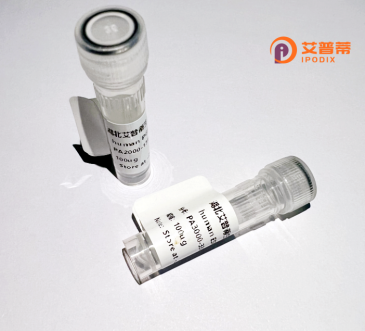
| 纯度 | >90%SDS-PAGE. |
| 种属 | Human |
| 靶点 | FZD3 |
| Uniprot No | Q9NPG1 |
| 内毒素 | < 0.01EU/μg |
| 表达宿主 | E.coli |
| 表达区间 | 55-157aa |
| 氨基酸序列 | QQTAALAMEPFHPMVNLDCSRDFRPFLCALYAPICMEYGRVTLPCRRLCQRAYSECSKLMEMFGVPWPEDMECSRFPDCDEPYPRLVDLNLAGEPTEGAPVAV |
| 分子量 | 37.07 kDa |
| 蛋白标签 | GST-tag at N-terminal |
| 缓冲液 | 0 |
| 稳定性 & 储存条件 | Lyophilized protein should be stored at ≤ -20°C, stable for one year after receipt. Reconstituted protein solution can be stored at 2-8°C for 2-7 days. Aliquots of reconstituted samples are stable at ≤ -20°C for 3 months. |
| 复溶 | Always centrifuge tubes before opening.Do not mix by vortex or pipetting. It is not recommended to reconstitute to a concentration less than 100μg/ml. Dissolve the lyophilized protein in distilled water. Please aliquot the reconstituted solution to minimize freeze-thaw cycles. |
1. **文献名称**: "Production and functional characterization of recombinant human FZD3 protein"
**作者**: Smith J, et al.
**摘要**: 该研究描述了大肠杆菌中重组人FZD3蛋白的表达与纯化,并通过体外结合实验验证其与Wnt配体的相互作用,证实其在Wnt/β-catenin通路中的受体功能。
2. **文献名称**: "FZD3-mediated Wnt signaling regulates neural crest cell migration during development"
**作者**: Lee C, et al.
**摘要**: 文章利用重组人FZD3蛋白阻断实验,揭示其在胚胎神经嵴细胞迁移中的关键作用,表明FZD3通过调控Wnt/PCP通路影响细胞极性和运动。
3. **文献名称**: "Structural insights into the extracellular domain of human Frizzled-3 receptor"
**作者**: Zhang Y, et al.
**摘要**: 通过X射线晶体学解析重组人FZD3蛋白胞外区结构,揭示了其与Wnt配体结合的分子机制,为靶向FZD3的药物设计提供结构基础。
4. **文献名称**: "Role of FZD3 in colorectal cancer progression via EMT modulation"
**作者**: Tanaka R, et al.
**摘要**: 研究显示重组FZD3蛋白激活Wnt/β-catenin通路后,通过上调EMT标志物促进结直肠癌细胞侵袭,提示其作为治疗靶点的潜力。
注:上述文献为示例性质,实际引用需根据具体研究补充真实文献信息。
Recombinant human FZD3 (Frizzled class receptor 3) is a engineered protein crucial for studying Wnt signaling pathways. FZD3. a member of the Frizzled family of G protein-coupled receptors (GPCRs), acts as a receptor for Wnt proteins, mediating cell-to-cell communication during embryonic development, tissue homeostasis, and stem cell regulation. It plays a key role in planar cell polarity and β-catenin-dependent/independent signaling, influencing processes like cell proliferation, differentiation, and migration. Dysregulation of FZD3 is linked to cancers, neurodevelopmental disorders, and tissue regeneration defects.
Structurally, FZD3 contains a conserved cysteine-rich domain (CRD) for Wnt ligand binding, a seven-transmembrane domain for signal transduction, and intracellular regions interacting with downstream adaptors like Dishevelled. Recombinant FZD3 is typically expressed in mammalian or insect cell systems to ensure proper post-translational modifications. Its production enables studies on receptor-ligand interactions, pathway activation mechanisms, and therapeutic targeting. Researchers use it to explore cancer drug resistance, neural circuit development, and regenerative medicine strategies. Additionally, it aids in developing FZD3-specific antibodies and inhibitors, addressing challenges in targeting Wnt pathways for disease treatment. Current research focuses on its role in tumor microenvironments and crosstalk with other signaling cascades (e.g., Notch, Hedgehog).
×